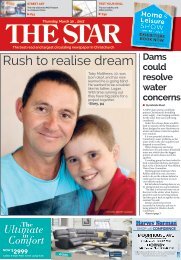Review of the Tsunami Evacuation 2017
Create successful ePaper yourself
Turn your PDF publications into a flip-book with our unique Google optimized e-Paper software.
Appendix III<br />
Ministry <strong>of</strong> Civil Defence & Emergency Management Feedback on <strong>the</strong> Draft Report<br />
Page Section Content MCDEM feedback<br />
number<br />
N/A All General comments on <strong>the</strong><br />
earthquake and tsunami which<br />
could be added to <strong>the</strong> executive<br />
summary and in appropriate<br />
locations within <strong>the</strong> final “<strong>Review</strong><br />
<strong>of</strong> <strong>the</strong> tsunami evacuation” report.<br />
It is important that <strong>the</strong>se observations be prefaced with some context on how <strong>the</strong> scientific<br />
information available changed as <strong>the</strong> event unfolded. As explained below, <strong>the</strong>se changes<br />
subsequently affected <strong>the</strong> type <strong>of</strong> National Warning System (NWS) messages issued. NWS<br />
messages are designed to prioritise threats to people and property, while also taking into<br />
consideration <strong>the</strong> inherent uncertainty <strong>of</strong> many hazard events.<br />
Scientific advice and MCDEM<br />
response<br />
This event has now been described by scientists as <strong>the</strong> most complex earthquake in historical<br />
times worldwide, with 21 separate faults over 140 km rupturing in sequence (GNS Science live<br />
presentation to Media, March 12).<br />
Key points (expanded later):<br />
• All decisions made regarding tsunami warnings by MCDEM are based on scientific advice<br />
using thresholds agreed between MCDEM and GNS Science.<br />
• All MCDEM plans and guidelines relevant to tsunami warnings state that <strong>of</strong>ficial warnings<br />
will not be able to be provided for local source tsunami before waves arrive<br />
• MCDEM plans, procedures, technical standards and guidance stress <strong>the</strong> importance <strong>of</strong><br />
pre-planning with communities and public education and exercises to support immediate<br />
self-evacuation following natural warnings <strong>of</strong> local source tsunami.<br />
For an hour after <strong>the</strong> main shock, GeoNet, New Zealand’s geological hazard monitoring agency<br />
was locating <strong>the</strong> earthquake as an on-land event with no chance <strong>of</strong> a tsunami being generated.<br />
This was <strong>the</strong> case until tsunami gauges showed that tsunami waves had been generated (40<br />
minutes after <strong>the</strong> main shock).<br />
At this point it was recognised by GeoNet and communicated to MCDEM that <strong>the</strong> earthquake had<br />
also caused significant <strong>of</strong>f-shore disturbance, large enough to trigger a threatening tsunami. This<br />
emphasises <strong>the</strong> complexity and uncertainty <strong>of</strong> very large earthquakes and <strong>the</strong> difficulties for<br />
scientists and emergency managers in assessing tsunami threat for local earthquakes. For this<br />
reason, messaging regarding warnings for local source tsunami from MCDEM has for many years<br />
(at least since 2008), been that for local tsunami threat <strong>of</strong>ficial warnings are not reliable and may<br />
arrive after <strong>the</strong> first waves have already hit. MCDEM <strong>of</strong>ficial advice is that natural warnings <strong>of</strong> long<br />
60















